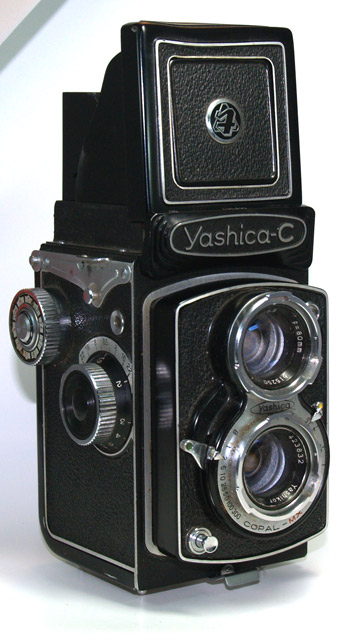Yashima Optical Industry Company, Ltd (Yashica Kōgaku Seiki K.K.) Taiyodo Koki (TKK), Japan (Beautyflex)

Three allmost identical Japanese twin-lens reflex cameras. Firs two made by
Yashima Optical Industry and the last made by Taiyodo Koki (TKK)
Yashicaflex
The story of Yashica cameras begun in 1948 in Nagano Japan. The first TLRs were named, Pigeonflex and the last Yashica TLR cameras were produced in 1986. The era of more complicated single-lens reflex cameras (SLR) was ante portas.
- Film type 120
- Picture size 6 x 6 (12 exp.)
- Lens Tri-Lausar/Yashicor 80mm f3.5
- Shutter Copal B, 1 to 1/300
- Shutter speed B , 1 - 1/300sec
- Self timer Yes
- Flash contact Yes , X-sync.
- Size (WxHxD) 95 x 140 x 105mm (closed)
- Weight ~ 860g
- Serial 546494
Both these cameras could be dated between 1954 -1958. The difference in the names is somehow unclear to me but one reason could be Rolleiflex and particularly that last part "flex". It could have been disagreeable to the Franke & Heidecke GmbH, the manufacturer of Rolleiflex cameras. I doubt because there have been so many different "flexes" among the camera model names in the history. Some other similarities would have been more irritating instead. |
| |
|

Yashica-C
Both cameras here could be considered as a entry level cameras. Winding is done by the knob and the shutter must be cocked separately . Yashica took the Rolleiflex route of wind lever and auto-cocking shutter in later models.
There are a couple of disadvantages in the TLR cameras that turned the consumer preferences towards single-lens reflex (SLR) cameras.
- Film type 120
- Picture size 6 x 6 (12 exp.)
- Lens Yashicor 80mm f3.5
- Shutter Copal MX B, 1 to 1/300sec
- Shutter speed B , 1 - 1/300sec
- Self timer Yes
- Flash contact Yes , X-sync.
- Size (WxHxD) 95 x 140 x 105mm (closed)
- Weight ~ 860g
- Serial 805490
The development steps in film and lenses made possible to use smaller negative format (35mm film) and thus enabled smaller cameras. The twin-lens reflex camera is a comparatively bulky with a fixed-mirror reflex housing and top screen mounted above a roll-film box camera. The inescapable parallax error is one of the disadvantages. You don't see what you get like in the SLR's.
Primary advantages are the simplicity of the construction and quietness. The only mechanical noise during exposure is from the shutter leaves opening and closing. |
| |

Taiyodo Koki (TKK), Japan (later Beauty com. Co. LTD, Japan)
Beautyflex D (1955)
Taiyodo Koki is one of the many forgotten Japanese camera manufacturers. I am not the only collector who has tried to get information about the manufacturer of Beauty(flex) cameras. All I know is what I have found from the pages of other collectors. About Beautyflex camera I can tell what I see and what I can meter and weigh.
The boom of Twin-Lens-Reflex (TLR) cameras started around in the middle of the fifties and Beautyflex D model is an example of them like also the two Yashica cameras on this page. Beaytyflex is a bit heavier but the dimensions are almost identical. Most of the contemporary Japanese TLR cameras were more or less copies of Rolleicord or alternatively clones of each others. Though the names followed Rolleiflex. (I used my spare time in searching all the possible camera related "flexes" in the world.)
- Film type 120
- Picture size 6 x 6 (12 exp.)
- Lens F.C. Biocor 80mm f3.5
- Viewing Lens Tri-Lausar 80mm f3.5
- Shutter Synchro MX, B, 1 to 1/300sec
- Shutter speed B , 1 - 1/300sec
- Self timer Yes
- Flash contact Yes , X-sync.
- Size (WxHxD) 95 x 140 x 105mm (closed)
- Weight ~ 890g
- Serial (Lens) 23928
Agfaflex Accuraflex Agiflex Airesflex Amiflex Alpenflex Alsaflex Altiflex Ambiflex Amiflex Anscoflex Argoflex Art-flex Asahiflex Astraflex Atoflex Autoflex Beautyflex Beroflex Bessaflex Biflex Bioflex Boldaflex Bolseyflex Celtaflex Ciroflex CLIX-O-FLEX Colorflex Contaflex Chrystarflex Cosmoflex Dorimaflex Dorisflex Druoflex Dualflex Duflex Ediflex Elbaflex Elcaflex ElegaflexElioflex Elmoflex
Ernoflex
Embirflex
Escaflex
Fineflex
Firstflex
Fokaflex
Foth-Flex
Fujicaflex
Fulvueflex
Gee-Flex
Gehaflex
Geltoflex
Gemflex
Gnoflex
Graflex
Grenaflex
Hacoflex
Hafaflex Hobiflex
Honestflex
Honorflex
Hobiflex
Icoflex
Inflex
Interflex
Isocaflex
Isoflex
Itohflex
Kalloflex
Karma-Flex
Kikuflex
Kinaflex
Kinoflex
Komaflex
Koniflex
Kowaflex
Kwikflex Laurelflex
Leadaflex
Leicaflex
Linco-Flex
Lippo-Flex
Luckyflex
Lumiflex
Lustreflex
Lyraflex
Makiflex
Malaflex
Mamiyaflex
Mananflex
Marioflex
Mecaflex
Meikaiflex
Mericaflex
Meseflex
Metascoflex
Metraflex Micriflex
Minoltaflex Mirageflex
Miroflex
Montiflex
Museflex
Myriaflex
Neiflex
Neucaflex
Nikkenflex
Nikkoflex
Noviflex
Ofunaflex
Olympusflex
Ontoflex
Optiflex
Orionflex
Osiroflex
Packflex
Pecoflex Pentaflex
Periflex
Petriflex
Photoflex
Picoflex
Pigeonflex
Primoflex
Prismaflex
Princeflex
Plascaflex
Pluscaflex
Praktiflex
Primarflex
Primoflex
Prinzflex
Rayflex
Rectaflex
Rediflex
Revueflex
Queenflex Ricohflex
Ripeflex
Rippaflex
Rolleiflex
Royflex
Samocaflex
Savoyflex
Scopaflex
Selectaflex
Semflex
Shinkoflex
Shur-Flex
Silverflex
Simflex
Spartaflex
Superflex
Symbolflex
Tanyflex
Taroflex
Teflex Tengoflex
Topcoflex
Toyocaflex
Tubasaflex
Twinflex
Ucaflex
Uniflex
Ultraflex
Veriflex
Vitaflex
Vitoflex
Vesterflex
Wagoflex
Walzflex
Welmyflex Weltaflex
Windsorflex
Wrayflex
Yashicaflex
Yashimaflex
Youngflex
Zeca-Flex
Zeniflex
Zenobiaflex |
©2006 Reijo Lauro